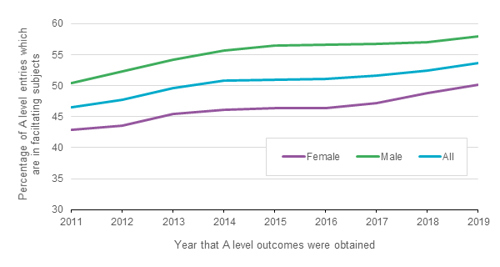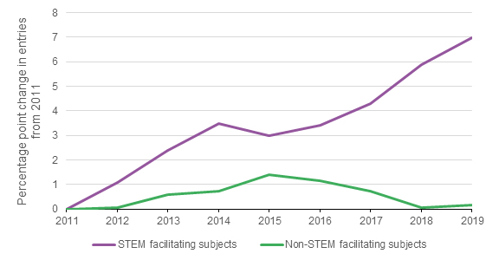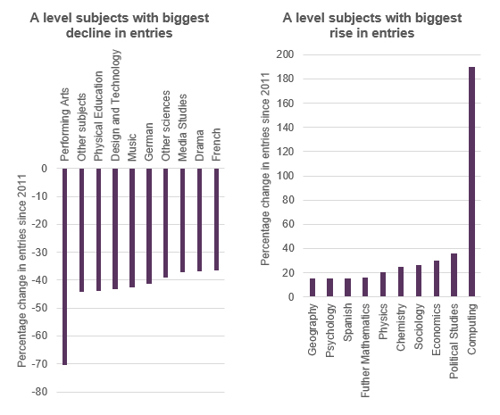A level entry patterns: How much influence did the Russell Group’s list of facilitating subjects have?
Thursday 15 August 2019
In May 2019, the Russell Group, which represents 24 top research-intensive UK universities, announced they would no longer be publishing their list of facilitating A level subjects, which they suggested would help pupils to secure a place at a top university.
This list has caused some controversy (e.g. see here, here) for focusing on traditional academic subjects at the expense of the arts and other creative subjects. In this blog, we look at the data to explore how entries into facilitating subjects in England have changed since the Russell Group first published their list.
What are facilitating subjects?
In 2011, the Russell Group published guidance advising students to take traditional subjects at A level. They recommended that students with ambitions to study at competitive universities should have A levels in at least two facilitating subjects to improve their chances of getting a place. The facilitating subjects are biology, chemistry, English literature, geography, history, maths, further maths, modern and classical languages, and physics.
What has happened to facilitating subjects entries since 2011?
Chart 1 shows that entries in facilitating subjects have increased year on year, from 46.6 per cent of all A level entries in 2011 to 53.7 per cent in 2019. This entry data is based on A level outcomes, so for most pupils it will reflect the subject choices made two years earlier. Chart 1 shows that much of the increase happened in the first few years following the Russell Group introducing their list, notably in 2013 when the proportion increased by two percentage points. Growth was slower between 2015 and 2017, but since has picked up to about one percentage point a year.
Chart 1: The proportion of A level entries in facilitating subjects have increased every year from 2011

Note: Before 2016, all entries for English literature, English language and English literature and language are grouped as “English”. We have therefore estimated the number of entries for English literature before 2016.
Source: 2011 to 2019 JCQ A level results data
While males opt to study facilitating subjects more than their female counterparts, both genders have seen an increase in the proportion of entries in these subjects since 2011. The difference in proportions of male and female entries widened over the period from 7.6 percentage points in 2011 to 10.2 percentage points in 2016, before dropping back nearly to 2011 levels in 2019. This is largely due to increasing entry numbers by females in biology and chemistry.
Is STEM the driving factor behind the rise in facilitating subjects?
There has been a well-documented push in recent years to increase the number of students, particularly girls, studying STEM subjects (Science, Technology, Engineering and Maths), (e.g. here, here). STEM subjects have risen in popularity since 2011, with some 37.3 per cent of all entries in one of these subjects in 2019, an increase from 30.2 per cent in 2011.
Many of these STEM subjects are included in the facilitating subjects list (biology, chemistry, mathematics, further mathematics and physics). As Chart 2 shows, the proportion of entries in STEM facilitating subjects has increased by seven percentage points between 2011 and 2019.
Conversely, uptake in the non-STEM facilitating subjects (English literature, geography, history, and modern and classical languages) in 2019 is much the same as it was in 2011. This suggests that the increase in facilitating subject entries has been driven entirely by STEM facilitating subjects.
Chart 2: The proportion of A level entries in STEM facilitating subjects has risen sharply compared to non-STEM facilitating subjects since 2011

Source: 2011 to 2019 JCQ A level results data
Winners and Losers
There has been a 7.5 per cent decline in A level entries since 2011. If there were zero change in the subjects chosen at A level since 2011, we would expect this percentage drop in every subject. However, as Chart 3 shows, there has been a lot of variation by subject. Non-facilitating subjects tend to make up the biggest losers, although German and French are also among this group.
Chart 3: Subjects with the biggest change in entries since 2011

Note: Only includes A level subjects which had at least 2000 entries
Source: 2011 to 2019 JCQ A level results data
Although entry numbers have decreased at A level, many subjects have actually seen a rise in the number of students entering these subjects since 2011. Computing has seen the most dramatic rise, which is likely to be due to recent A level reforms and more students opting to study computing instead. While facilitating subjects make up most of the 10 top subjects with increased entries, a few non-facilitating subjects like sociology, economics and political studies feature too.
In conclusion, it does appear that A level entry patterns have changed since the Russell Group started publishing their list. However, as most of the increase in entries are in STEM subjects, we cannot say for sure whether the Russell Group’s facilitating subjects list was responsible for the changes seen. Some other reasons may include a greater focus on STEM subjects, the impact of the EBacc, more information about degree returns, or a combination of factors. It will be interesting to continue to monitor how A level entry patterns change in future, if at all, following the Russell Group’s decision to stop publishing their list. But we have to wait at least a couple of years for that!
